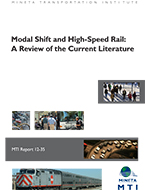- 408-924-7560
- mineta-institute@sjsu.edu
- Donate
Modal Shift and High-Speed Rail: A Review of the Current Literature
This report provides a review of scholarly literature with direct relevance to the topic of modal shift and high-speed rail (HSR). HSR systems are usually planned on the expectation that they will attract riders who would have chosen other modes (such as air, automobile, bus, etc.) had the HSR not been created. Identifying and measuring the actual ability of HSR to effect modal shift is therefore critical. This report examines the evidence concerning HSR and modal shift in both secondary analyses of previous studies and in newer studies that use primarily original data. The studies that were reviewed comprise a large variety of HSR systems, time periods, data sources, and means of analysis.
Although this literature is still in a formative stage, with key pieces of data and analysis still unavailable, the existing research is quite clear that HSR is extremely competitive with other modes. This finding emerges from essentially every study examined for this report and is reflected in outcomes from the HSR systems of Europe and Asia, with limited information from the US. The convergence of these multiple sources and analytic frameworks on similar results provides a reasonably secure basis for inferring that new HSR systems placed in appropriate travel corridors and managed well are likely to result in significant amounts of modal shift. Essentially, the literature affirms that HSR has resulted in significant-to-dramatic mode shifts where it has been systematically evaluated.
The most extensive and convincing information concerns HSR versus airline service. In both Europe and Asia, air service for specific routes was reduced, or even curtailed altogether, following coverage of the same routes by HSR. When HSR is faster from beginning to end of a trip, HSR gains market share rapidly and decisively. HSR market share also grows when time to access and egress the system; fare cost versus that of other modes; service frequency, service quality, and number of transfers required are compared.
The research concerning direct competition with automobiles, expresses buses, and other modes is much less highly developed, but also points to HSR service as effectively winning market share. Although this study does not include analysis of new data that would address the California HSR system, the findings from the research reviewed here are highly consistent with the expectation that the planned HSR system is well positioned to achieve comparable modal shift.
PETER J. HAAS, PhD
Dr. Peter Haas has been a faculty member in the Master of Science in Transportation (MSTM) program at the Mineta Transportation Institute (MTI) at San Jose State University since 1999 and was appointed Education Director in October 2001. He earned a PhD in Political Science (Public Policy and Public Administration) from the University of North Carolina at Chapel Hill in 1985. A former director of the SJSU Master of Public Administration program, he also has consulted at every level of government and for nonprofit agencies. As a Research Associate for MTI, Dr. Haas has authored numerous reports and other publications covering transportation, including topics relevant to high-speed rail workforce development and station planning, as well as transportation finance and tax initiatives. Haas is also co-author of the text Applied Policy Research: Concepts and Cases.
-
Contact Us
San José State University One Washington Square, San Jose, CA 95192 Phone: 408-924-7560 Email: mineta-institute@sjsu.edu






